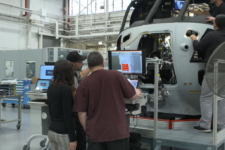
Publicity art from Akira Kurosawa’s “Rashomon”. (Photo by FilmPublicityArchive/United Archives via Getty Images)
The Pentagon wants to see venture capitol injected into the defense sphere, and VCs want to cash in on the Pentagon’s large budget. So why does there still seem to be an inability to craft a win-win? In this op-ed, Masao Dahlgren of the Center for Strategic and International Studies argues that the disconnect stems from an inability to agree on basic facts and strategy — and calls for both sides to get their story straight.
The Defense Department often maintains that rapid innovation is a priority. In the past few years, the Pentagon has developed dozens of innovation organizations, while venture investors have poured billions into startup-developed drones, hypersonic aircraft and military satellites.
One catch: while venture dealmaking in defense reached $26.9 billion last year, startups were awarded only a single percentage point of the DoD’s $411 billion in contracts — only half a percent higher than a decade before. That’s despite all the effort DoD has put into improving its relationship with venture-backed startups.
Changing this will require a comprehensive strategy — and a diagnosis. Earlier this month, the Pentagon’s newly-formed, $144 million Office of Strategic Capital released its first investment strategy, establishing loan guarantees for defense-focused investors. But a broader look is needed at whether that will make private investment sustainable.
Why is investing in defense a winning thesis? On the whole, both the Pentagon and venture funds are optimistic, pointing to the proliferation of innovation organizations, and investment in so-called defense tech — and related deep tech and dual-use firms — as a bright spot in a general downturn in investment. But these explanations risk becoming a Rashomon story. Like in Kurosawa’s masterpiece, none of the players involved—startups, venture capitalists and Washington — can agree on what is really happening.
One repeatedly offered thesis postulates a cultural shift in Silicon Valley. Russia’s attacks on Ukraine and US competition with China, the story goes, galvanized tech evangelists into action, breaking longstanding taboos on work with the Department of Defense. Moreover, the government-facilitated success of Palantir and SpaceX affirmed that defense-relevant startups could become billion-dollar unicorns. These star players have since incubated a motivated crop of defense-focused engineers and founders — creating a broader ecosystem for investment.
A second story points to the direct outputs of government policy. DoD investment in innovation organizations is a common narrative. Requirements to disclose technical readiness are another, purportedly reducing due diligence costs for investors wary of potential Theranoses and other busts. Meanwhile, the end of so-called zero interest rate policies, raising the relative cost of investment, prompted investment into national security sectors seen as underleveraged — despite the federal government’s historic difficulty as a customer.
A third strain of explanations offers a variation on these themes: that defense-relevant technologies have civilian applications, and that investment in these dual-use firms offers a gateway to larger commercial markets. The potential to access some broader civil application — in telecom, manufacturing, or cloud — has thus far justified billions in venture investment to chase millions in government contracts.
Each of these accounts leaves something incomplete. The star-player thesis raises questions over metrics, on the actual numbers of founders and engineers entering the sector. Interest-rate narratives might overrate the potential of the American defense market, with complex contract structures and mandated limits on profit. Dual-use approaches are uncertain in their applicability to civilian markets.
Without an overarching strategy, there is a risk that the dollars spent toward “American Dynamism” will, in its proponents’ words, become mostly “a feeling” — mirroring the ongoing bloodletting in space launch or additive manufacturing startups.
To be sure, American national security benefits from an influx of entrepreneurs and deep pools of private capital to fund them. But to fully reap these, the players will need to get their stories straight. While the OSC’s loan guarantees increase the runway available, will this be enough to survive the DoD’s infamously slow acquisition process? While much has been made about the Pentagon’s problems with investing in cutting-edge technologies, reforming acquisition, as former senior official Christine Michenzi has noted, will require “many hard decisions … [with] multiple people, organizations, and resources working in tandem.”
What is needed now is a greater strategy, informed by a shared diagnosis of the problem. The OSC’s recent initiatives are one piece, but are limited to financing, not acquisition and requirements reform. Will the Department of Defense use this opportunity to rethink its buying bureaucracy? While it has made incremental progress, such as by leveraging rapid acquisition authorities, it is worth reexamining first principles.
20th-century business leaders —so-called “whiz kids” — created the Pentagon budgeting system used today. Where are America’s “whiz kids” for the 21st? While government commissions have made valuable recommendations for improvement, there is room for entrepreneurs, investors and acquisition professionals to offer a blue-skies perspective.
The recent explosion in private investment cannot become a Rashomon moment. Both startups and the Pentagon enjoy a rare combination of funding and consensus; now is the opportunity to exploit it. A more comprehensive strategy to rationalize Department of Defense innovation is necessary, but this only becomes possible with a common story to tell.
Masao Dahlgren is a fellow with the Center for Strategic and International Studies, where he writes on national security and emerging technologies. He recently authored “Getting on Track: Space and Airborne Sensors for Hypersonic Missile Defense” and has commented for the Wall Street Journal, CNBC, Business Insider, and other outlets.
Sullivan: Defense industry ‘still underestimating’ global need for munitions
National Security Advisor Jake Sullivan said that there are “no plans” for another Ukraine supplemental at this point.


























